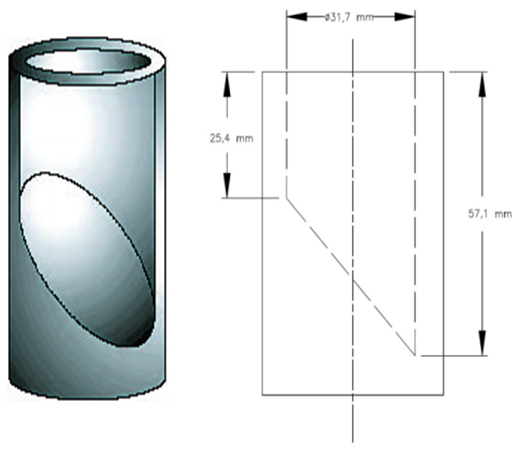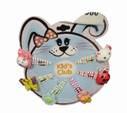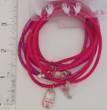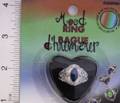Industry Guide to Children's Jewellery
Table of Contents
- Introduction
- Legislation
- Requirements under the Canada Consumer Product Safety Act and its regulations
- Background on heavy metals in children's jewellery
- What is "jewellery"?
- What is "children's jewellery"?
- Examples of children's jewellery
- Test methods for determining lead and cadmium content in children's jewellery
- Appendix A - Diagram of small parts cylinder
- Appendix B - Information resources
Introduction
This document provides information about the safety requirements that apply under the Canada Consumer Product Safety Act and under the Children's Jewellery Regulations to children's jewellery that is manufactured, imported, advertised or sold in Canada.
Additionally, this document will: explain how the Regulations apply to the lead and cadmium content of children's jewellery; define children's jewellery and help identify which products fall within the scope of the legislation; and provide information on test methods for determining lead and cadmium content in children's jewellery.
This document is an unofficial summary of the safety requirements for children's jewellery under the Children's Jewellery Regulations. It is not intended to substitute for, supersede or limit the requirements under the applicable legislation. In case of any discrepancy between this summary and the legislation, the legislation will prevail. For further information, contact a Health Canada Consumer Product Safety Office via email (ccpsa-lcspc@hc-sc.gc.ca) or telephone at 1-866-662-0666 (toll-free within Canada and the United States).
In addition to the requirements specified in the Children's Jewellery Regulations, children's jewellery is subject to the general requirements of the Canada Consumer Product Safety Act. Other regulations under the Act may apply. For more information, see Appendix B.
Legislation
Children's jewellery items manufactured, imported, advertised or sold in Canada are subject to the Canada Consumer Product Safety Act and Children's Jewellery Regulations.
In addition to the product-specific requirements noted in this document, it is prohibited to manufacture, import, advertise or sell any consumer product that is a "danger to human health or safety" as defined in the Canada Consumer Product Safety Act (see paragraphs 7(a) and 8(a)).
The onus is on industry to comply with the legislation.
The Consumer Product Safety Program administers and enforces the Canada Consumer Product Safety Act and its Regulations. Enforcement actions taken by Product Safety Officers on noncompliant products depend on the degree of hazard associated with noncompliance, and include commitment to product correction by industry, negotiation with industry for the voluntary removal of these products from the market, seizure and/or prosecution under the Canada Consumer Product Safety Act. Any person that manufactures, imports, advertises, or sells noncompliant products that result in property damage, injury or death may also be subject to legal liability.
Requirements under the Canada Consumer Product Safety Act and its regulations
The Children's Jewellery Regulations under the Canada Consumer Product Safety Act set limits on total lead and total cadmium content to help protect children from toxicity associated with lead or cadmium exposure.
Children's Jewellery Regulations
Definition
The Children's Jewellery Regulations define children's jewellery as:
Jewellery that is manufactured, sized, decorated, packaged, advertised or sold in a manner that appeals primarily to children under 15 years of age but does not include merit badges, medals for achievement or other similar objects normally worn only occasionally.
Table 1 of this Guide shows examples of children's jewellery.
Requirements
Children's jewellery, when tested using good laboratory practices, must not contain more than 90 mg/kg of total lead.
A children's jewellery item that is small enough to be totally enclosed in the small parts cylinder (Appendix A), with the application of a 4.45 N force, must not contain more than 130 mg/kg of total cadmium, when tested using good laboratory practices. The small parts cylinder is an internationally recognized gauge used to determine if an item is of a size and shape that make it an ingestion or choking hazard to young children.
Children's jewellery must comply with both the total lead and total cadmium limits.
The Children's Jewellery Regulations limits for total lead and total cadmium apply to all materials, including metallic and non-metallic materials, such as glass and crystal components. The limits apply to any coatings on the jewellery.
Children's jewellery items such as beads, chains and clasps, which are available individually or in jewellery-making kits, rather than as a finished jewellery item, must also meet the requirements of the Children's Jewellery Regulations.
Application of the requirements
Health Canada tests each part of a children's jewellery item independently against the requirements.
The total lead test is applied to all parts and the total cadmium test is applied to any part that is defined as a small part because it can be totally enclosed in the small parts cylinder. For instance, if the jewellery consists of a chain, a clasp and a pendant, the chain, clasp and pendant are tested separately to see if any is a small part. Each part is tested separately for total lead and total cadmium content because jewellery may break into its parts during normal and reasonably foreseeable use and misuse, and because the lead or cadmium content may be different for each part item.
Good laboratory practices
"Good laboratory practices" means practices that are in accordance with the principles set out in the Organisation for Economic Co-operation and Development's (OECD) document entitled OECD Principles of Good Laboratory Practice, Number 1 of the OECD Series on Principles of Good Laboratory Practice and Compliance Monitoring, ENV/MC/CHEM(98)17, the English version of which is dated January 21, 1998 and the French version of which is dated March 6, 1998. (For a link see "Information resources", in Appendix B.)
Jewellery for adults
The Children's Jewellery Regulations do not restrict the lead or cadmium content of jewellery intended for adults or children aged 15 years or older. However, industry is encouraged to avoid the use of lead and cadmium in all jewellery items.
Background on heavy metals in children's jewellery
Lead and cadmium are toxic metals that may be found in children's jewellery. Although there are no known risks to health from jewellery containing lead or cadmium touching the skin, there are serious, potentially fatal risks from ingesting lead or cadmium.
Lead
Lead may be used in making children's jewellery because it is inexpensive and easily molded. It has a sweet taste that may encourage children to repeatedly chew or suck on lead-containing jewellery.
If ingested, lead can affect the nervous system and is especially harmful to children. Recent studies suggest even small amounts of lead in the body can cause learning and behavioural problems in children. At high levels of exposure, lead can cause seizures, coma and death. Since lead builds up in the body, ongoing exposure to even very small amounts of lead can result in large amounts of lead being present in the body.
It has been demonstrated, with tragic consequences, that swallowed jewellery containing lead may become lodged in the stomach or gastrointestinal tract, which can result in the release of large amounts of lead over time.
Several cases of lead poisoning in children have been linked to children's jewellery containing lead. In 2006, a child from the United States died of lead poisoning after swallowing a children's charm with a high lead content.
Cadmium
The health concerns surrounding lead in children's jewellery have raised similar concerns of cadmium exposure from children's jewellery. Unlike lead, cadmium tastes very bitter and it is unlikely that children would repeatedly suck or chew items made with cadmium. Swallowing is considered the most likely route of exposure for cadmium in children's jewellery. Ingested cadmium has been associated with harmful effects on the kidneys, liver and blood, and on the cardiovascular, neurological, reproductive/ developmental and immune systems.
After the introduction of lead limits for children's jewellery, Health Canada found high levels of cadmium in various items of children's jewellery in the Canadian marketplace, suggesting that cadmium was being substituted for lead in certain low-cost children's jewellery. Cadmium in children's jewellery has been detected at levels up to 93%.
What is "jewellery"?
For purposes of the Children's Jewellery Regulations, an item of jewellery is considered to be any decorative item intended for regular wear on the body or on clothing or clothing accessories. This includes some items which might not ordinarily be described as jewellery, such as zipper pulls and shoelace charms.
Functional items like watches and hair clips, and functional components of clothing and accessories such as buttons and belt buckles, are not considered as jewellery, unless they are designed or marketed in a way which clearly indicates that their primary purpose is decorative. However, purely ornamental parts, such as beads and charms, clothing fasteners and hair accessories that appeal primarily to children under 15 years of age, are subject to the lead and cadmium content requirements of the Children's Jewellery Regulations.
What is "children's jewellery"?
Children's jewellery is defined in section 1 of the Children's Jewellery Regulations as "jewellery that is manufactured, sized, decorated, packaged, advertised or sold in a manner that appeals primarily to children under 15 years of age."
For the purposes of the Children's Jewellery Regulations, jewellery items shall be considered as appealing primarily to children under 15 years of age if, for example:
- The jewellery item, or one or more of its components, is manufactured with a "play value," making it likely that the item will be perceived or used as a play item. Examples include:
- a necklace with a flashing light.
Any toy components (intended for use by a child in learning or play) must meet all applicable requirements of the Toys Regulations. If the design of a product or product component clearly indicates that it could be used either as a toy or for regular wear as a jewellery item, the product or product component must meet the requirements for both jewellery and toys.
- The jewellery is decorated with figures, logos or designs that are primarily associated with products aimed at children. Examples include:
- characters from movies marketed for children
- characters from public information programs marketed toward children
- characters associated with video games marketed toward children.
- The size and/or design of the jewellery item make it unlikely that an adult would regularly wear it. Examples include:
- ring with band too small to fit an average adult finger.
- The price and/or quality of the jewellery item are low enough to make it unlikely that an adult would be given the item or choose it for themselves.
- The jewellery item is labelled and/or packaged in a way that appeals primarily to children or that suggests the product is intended primarily for children. Examples include:
- packaging that includes illustrations of logos or characters associated primarily with children's products
- packaging that includes images of children,
- labelling or packaging that includes the word "kid's," "for children" or similar
- packaging that includes text or images intended to or likely to appeal mainly to children.
- The jewellery item is advertised in conjunction with another product intended primarily for use by a child or in caring for a child. Examples include:
- jewellery distributed with a child's high chair or stroller.
- The jewellery item is advertised in conjunction with or as a part of television, video, radio or other programming aimed primarily at children under 15 years of age or in printed material targeted primarily at children under 15 years of age. Examples include:
- "prizes" distributed inside cereal boxes or other packaged foods
- advertisements aired during or immediately before or after a television show that is primarily targeted at a child audience.
- The jewellery item is advertised or sold in conjunction with, as an attachment to, or packaged together with another product intended for use by a child or for use by an adult in caring for or entertaining a child.
Examples include:- jewellery items sold together with a child's dress
- jewellery items attached to a book, video game or DVD aimed at children under 15 years of age.
A jewellery item worn by a toy, such as a doll or plush toy, would generally be classified as a toy, rather than as children's jewellery, unless the jewellery item was clearly intended primarily for wear by a child. Components classified as toys must meet all applicable requirements of the Toys Regulations made under the Canada Consumer Product Safety Act.
- The jewellery item is advertised, displayed or sold on premises that market exclusively or mainly children's products, or in a section of a store or other premisesFootnote 1 where other children's items are sold, advertised or displayed.
- The jewellery item is sold at an entertainment, educational or sporting event that is marketed towards or likely to be attended by children under 15 years of age.
- The jewellery item is sold or distributed through premises or under circumstances that would result in the presence of large numbers of children or in which children are the primary marketed target. Examples include:
- schools or daycare centers
- cinemas screening children's or family rated movies
- trade shows for products intended for use by children or for adults in caring for children.
- The jewellery item is sold in a vending machine located in an area accessible to children.
This list is not intended to be all-inclusive. Jewellery items will be classified on a case-by-case basis taking into account all relevant factors.
For additional information, please contact the nearest Health Canada Consumer Product Safety Office through the telephone number or e-mail address provided in Appendix B.
Examples of children's jewellery
The following are examples of children's jewellery and the rationale for their classification.
| Item | Rationale for Classification |
|---|---|
Animal brooch
|
|
Birthstone ring
|
(This item would not be classified as children's jewellery on the basis of its appearance alone.) |
Bracelet with apple and heart charms
|
|
Butterfly pendant
|
|
'Canada' pendant necklace
|
|
Hairclips
|
|
Headband with feathers and tiara
|
|
Metallic charms on plastic wristbands
|
|
Mood ring
|
|
Mood stone bracelet
|
|
Pendant on cord
|
|
Set of toe rings
|
|
Teddy bear ring with mood stone
|
|
Turtle pendant sold for use in jewellery-making classes
|
|
(Note: only the ornamental components of the hairclips, for example, bunny face and ladybug, are subject to the Children's Jewellery Regulations.) |
|
Test methods for determining lead and cadmium content in children's jewellery
Industry is responsible for making sure their products comply with the Children's Jewellery Regulations. Health Canada does not specify or recommend any particular test methods to test jewellery for total lead or cadmium content. However, any methods used to test the lead or cadmium content of jewellery for the purpose of assessing compliance with the Children's Jewellery Regulations must comply with Organisation for Economic Co-operation and Development's (OECD) Principles of Good Laboratory Practice, Number 1 of the OECD Series on Principles of Good Laboratory Practice and Compliance Monitoring, ENV/MC/CHEM(98)17 (see "Information resources" in Appendix B).
Any digestion methods, as well as any analytical instruments, that allow the determination of total lead and cadmium content in jewellery items are acceptable provided that control-certified materials and standards are used to monitor the quality of the results.
In conducting enforcement of the Regulations, Health Canada uses the following test methods to determine total lead and total cadmium, in jewellery:
- C02.2.2 Determination of Total Lead in Surface Coating Materials in Consumer Products by Inductively Coupled Plasma Optical Emission Spectroscopy (ICP-OES)
- C02.3.1 Determination of Total Lead and Cadmium in Plastic Products by Inductively Coupled Plasma Optical Emission Spectroscopy (ICP-OES)
- C02.4.1 Determination of Total Lead and Cadmium in Metallic Consumer Products by Inductively Coupled Plasma Optical Emission Spectroscopy (ICP-OES)
- M00.1 Small Components (consumer product including its components, parts or accessories)
To obtain Health Canada's test methods, complete the Enquiry Form. Under Program, select Consumer Product Safety. Then, under Enquiry Type, select Test Method Request.
Appendix A - Diagram of small parts cylinder
A diagram of the small parts cylinder is shown below (refer to the Schedule in the Children's Jewellery Regulations).

Appendix B - Information resources
NOTICE: For further information visit the resources below or contact a Health Canada Consumer Product Safety Office via email (ccpsa-lcspc@hc-sc.gc.ca) or telephone at 1-866-662-0666 (toll-free within Canada and the United States).
- Canada Consumer Product Safety Act
- Children's Jewellery Regulations
- Toys Regulations
- Organisation for Economic Co-operation and Development (OECD) Principles of Good Laboratory Practice
- Canada Consumer Product Safety Act Quick Reference Guide
- To subscribe for email updates about the Canada Consumer Product Safety Act
- Guidance on Mandatory Incident Reporting under the Canada Consumer Product Safety Act - Section 14 Duties in the Event of an Incident
Footnotes
- Footnote 1
For the purposes of enforcing the Children's Jewellery Regulations, 'premises' are considered to include vehicles, kiosks, street stands and any other place where or from which jewellery items are displayed, advertised, distributed or sold.













